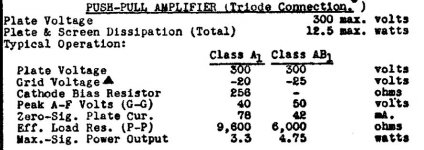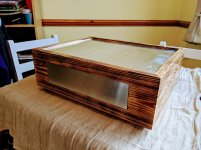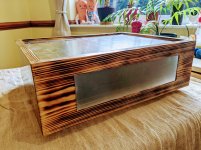The ins and outs of paralleling tubes was the cover article of the last issue of "Glass Audio".
"Paralleling Tubes Effects", Glass Audio, Volume 12, Number 5 2000.
The article included measurements, Listening sessions, design considerations, etc.
"Paralleling Tubes Effects", Glass Audio, Volume 12, Number 5 2000.
The article included measurements, Listening sessions, design considerations, etc.
I would say it appears that the amp is working as designed.
But I think one of your issues is that you were expecting (wanting) more power from those 6V6 tubes.
Did I understand you correctly?
///
Have fun listening to what you have.
Then decide if you want to keep the amp the same, or re-design it.
Then build another completely different amplifier as your next project.
Thanks, I'm pleased it's doing what it was designed to do - that was my main concern! I'm happy listening to it as it is, though haven't tried it on the main system in a bigger room. A modified version for a new project sounds like a good plan.
I'm not seeking more power out of this musical machine design, just wanted to be sure that the clipping behaviour I was seeing, and power levels, were what it was supposed to be doing! 🙂 Thanks for your help with it - I know a lot more now about how these things function than I did!
Normally i'm a bit of a naysayer (hence my handle), but I think your implementation including the laser → etch business is pretty darn good. Nice job!
Personally, I would simply double-up the output valves, putting either 2 in parallel at each 6V6 position. Nothing fancy from a current-sharing protocol, just a few 100 Ω plate resistors to even things out.
Thanks! Really appreciate that, nice when DIY efforts work out. 🙂 Been building a wood/alu enclosure for it over the Christmas break, and I'm far more inept with wood than I am with electronics. 😱
Interesting idea on the parallel output stage for a second variation on it.
Cheers! PC
The ins and outs of paralleling tubes was the cover article of the last issue of "Glass Audio".
"Paralleling Tubes Effects", Glass Audio, Volume 12, Number 5 2000.
Brilliant, where can I find that?
This should make you feel better about the power output you are seeing 😀. With your small transformer actual power will be less.
Hehe, fantastic - which datasheet is that from? 🙂
Cheers! PC
Attached a couple of box pics... 🙂
Continuing the, erm, cost-effective theme of this project, it's just a mitred cheap-pine box. I attacked it with the blowtorch for a shou-sugi-ban effect. Kept me quiet over Christmas.
PC
Continuing the, erm, cost-effective theme of this project, it's just a mitred cheap-pine box. I attacked it with the blowtorch for a shou-sugi-ban effect. Kept me quiet over Christmas.

PC
Attachments
Hehe, fantastic - which datasheet is that from? 🙂
Cheers! PC
AWV Radiotron, there are only 2 datasheets that show triode push pull data, that one and Brimar:
https://frank.pocnet.net/sheets/084/6/6V6GT.pdf
https://frank.pocnet.net/sheets/155/6/6V6G.pdf
paultheg33k,
In 2001, the publisher of several publications combined Glass Audio with 2 or 3 other of his publications, into AudioXpress. That was Ed T. Dell.
I have never posted the Glass Audio article on the web, it is copyrighted.
I am not sure who you would contact for permission now.
At VSAC 2003 (Vacuum Tube State of the Art Conference), I presented the principles, and findings of the research and article that 3 of us did, and wrote up for Glass Audio 2000.
The Oregon Triode Society knew about our research, there were 3 different sets of OTS members at 3 different venues who did the 'blindfolded' listening tests.
And a 'co-worker' of mine (clear across the US), noticed my article.
Other than that, for the most part, it went un-noticed.
In 2001, the publisher of several publications combined Glass Audio with 2 or 3 other of his publications, into AudioXpress. That was Ed T. Dell.
I have never posted the Glass Audio article on the web, it is copyrighted.
I am not sure who you would contact for permission now.
At VSAC 2003 (Vacuum Tube State of the Art Conference), I presented the principles, and findings of the research and article that 3 of us did, and wrote up for Glass Audio 2000.
The Oregon Triode Society knew about our research, there were 3 different sets of OTS members at 3 different venues who did the 'blindfolded' listening tests.
And a 'co-worker' of mine (clear across the US), noticed my article.
Other than that, for the most part, it went un-noticed.
AWV Radiotron, there are only 2 datasheets that show triode push pull data, that one and Brimar:
Cheers, I've looked at a few but not spotted those with the additional info.
paultheg33k,
The Oregon Triode Society knew about our research, there were 3 different sets of OTS members at 3 different venues who did the 'blindfolded' listening tests.
And a 'co-worker' of mine (clear across the US), noticed my article.
Other than that, for the most part, it went un-noticed.
Thanks for the background.
Looks like HifiCollective in the UK has back issues - your article is in the 2000 bundle?
Glass Audio CD back issues | Hifi Collective
It feels like a good few commercial designs run parallel output valves, why do you think it went so unnoticed?
Cheers, PC
Personally, I would simply double-up the output valves, putting either 2 in parallel at each 6V6 position. Nothing fancy from a current-sharing protocol, just a few 100 Ω plate resistors to even things out.
⋅-⋅-⋅ Just saying, ⋅-⋅-⋅
⋅-=≡ GoatGuy ✓ ≡=-⋅
Where do these current sharing plate resistors sit? Looking at a few schematics, a lot just appear to have the parallel valves directly connected, with much of the concern being about bias matching?
Cheers, PC
Glass Audio, Volume 12, Number 5 2000
Paralleling Tubes Effects was the cover article.
That was the very last issue of Glass Audio.
In 2001, the first issue of AudioXpress combined Glass Audio, Speaker Builder, and Audio Electronics.
Who knows why it seemed to be an unnoticed article?
There were 600 measurements of DC, AC, scope, and spectrum analyzer of 20 6SN7 tubes (40 triodes), the data was analyzed and collated; There was a test amplifier with two two position switches, parallel drivers, parallel outputs, parallel both, and parallel none - that was the 3 venue blindfold test, no voting, just 'can you hear a difference when the switches are randomly changed for multiple combinations, many many times.
Then there were the graphical and math proofs; a discussion of how to successfully parallel tubes and not make it sound good, not bad as so many are done the wrong way; and finally a logical proof where the question was, are all the spacings on one side of your favorite triode exactly the same as all the spacings on the other side of that triode (those 2 sides are in parallel).
It all started when two of us said, gee, we can do some testing and prove that parallel tubes do sound bad.
Just the opposite is true, when the correct measures are taken.
Without those measures, the tests showed that they could sound bad.
The measurements proved both the good and the bad, depending on how the circuit was implimented.
Paralleling Tubes Effects was the cover article.
That was the very last issue of Glass Audio.
In 2001, the first issue of AudioXpress combined Glass Audio, Speaker Builder, and Audio Electronics.
Who knows why it seemed to be an unnoticed article?
There were 600 measurements of DC, AC, scope, and spectrum analyzer of 20 6SN7 tubes (40 triodes), the data was analyzed and collated; There was a test amplifier with two two position switches, parallel drivers, parallel outputs, parallel both, and parallel none - that was the 3 venue blindfold test, no voting, just 'can you hear a difference when the switches are randomly changed for multiple combinations, many many times.
Then there were the graphical and math proofs; a discussion of how to successfully parallel tubes and not make it sound good, not bad as so many are done the wrong way; and finally a logical proof where the question was, are all the spacings on one side of your favorite triode exactly the same as all the spacings on the other side of that triode (those 2 sides are in parallel).
It all started when two of us said, gee, we can do some testing and prove that parallel tubes do sound bad.
Just the opposite is true, when the correct measures are taken.
Without those measures, the tests showed that they could sound bad.
The measurements proved both the good and the bad, depending on how the circuit was implimented.
Last edited:
- Home
- Amplifiers
- Tubes / Valves
- 6v6 Musical Machine - Clipping & power expectations


